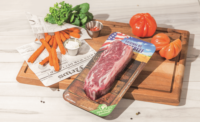High Steaks
U.S. beef processors endeavor to keep up with pressing consumer demands on the meat case, including more variety, convenient products, and case-ready packaging.
Despite headline-making bovine spongiform encephalopathy (BSE) issues and an already tight cattle market, beef demand has not suffered. Consumer demand jumped sharply in 2004, with the Beef Demand Index climbing 7.74 percent compared to 2003 --- and more than 25 percent since reversing its 20-year decline in 1998, relays the Centennial, CO-based Cattlemen’s Beef Board. Moreover, consumers spent more for beef in 2004 than any other time in history, with total consumer expenditures topping $70 billion.
Meat consumption is being aided by favorable dietary trends, with prepared meat, both value-added and heat-and-serve entrées, leading the way. Increased branding and the continued growth of the case-ready category are also working together to boost the beef market, while protecting it from the adverse effects of commodity-like swings.
Among the biggest news on the retail beef products front is the increased presence of beef value cuts, single-muscle cuts from the undervalued chuck and round. Identified through checkoff-funded research, the value cuts offer easy preparation, greater consistency, and more lean beef product options for consumers.
Randy Irion, director of retail marketing for the National Cattlemen's Beef Association (NCBA), Washington, D.C., points to the Flat Iron Steak as a value cuts success story. “The Flat Iron is now available in more than 2,500 stores through a wide variety of retailers,” he says. “It hasn't gone chain-wide with a lot of retailers, but we expect that will happen fairly soon.”
New to the case-ready category, a line of consumer-ready beef products that tout a shelf life of up to 28 days has been introduced by Greeley, CO-based Swift & Co. The ready-to-cook beef products, complete with their own preparation instructions, include brisket (flat split), back ribs (center cut), flank steak, and chuck shoulder tender (teres major).
| Annual Beef Forecasts | |||||||
| 2001 | 2002 | 2003 | 2004 | 2005 | 2006 | ||
| Production (millions lb.) | 26,107 | 27,090 | 26,238 | 24,548 | 25,202 | 25,975 | |
| Per capita consumption (retail lb.)* | 66.2 | 67.6 | 64.9 | 66.1 | 67 | 68.1 | |
| Beef and veal exports (millions lb.) | 2,269 | 2,447 | 2,518 | 461 | 625 | 660 | |
| Beef and veal imports (millions lb.) | 3,164 | 3,218 | 3,006 | 3,679 | 3,701 | 3,740 | |
| *Per capita meat consumption data are revised, incorporating a new population series from the Commerce Department’s Bureau of Economic Analysis based on the 2000 Census. Source: World Agricultural Supply and Demand Estimates and Supporting Materials Published in Livestock, Dairy, and Poultry Outlook, http://www.ers.usda.gov/publications/ldp/ | |||||||
Each of the case-ready products is wet-aged and available in choice or select grades. “When evaluating a beef roast or steak, consumers want convenience, a clear view of the product to feel confident they are buying a quality piece of meat, and a clue what to do with it,” notes Swift & Co., adding that, “We cut the product to be consumer-ready, which eliminates additional handling and opportunities for contamination.”
Branded products on the rise
Working hand in hand with case ready, the beef industry is experiencing increased product branding with some major retailers. Most notably, discount retail giant Minneapolis, MN-based Target Corp. recently launched its Sutton & Dodge premium steak line at SuperTarget stores across the United States. The case-ready line of USDA Choice Angus beef cut into filets, strips, ribeye, T-bone steaks, and roasts is priced from $3.49 to $12.99 per pound. Sutton & Dodge was created by Austin, MN-based Hormel Foods.
Beyond retail growth, foodservice menus are being augmented with new beef options. The beef checkoff this year partnered with Boston Market to introduce new roasted top sirloin meals, for example. The 5- and 8-ounce lean steak entrées, a BBQ Sirloin and Cheddar deli-sliced carver sandwich and a Sirloin Dip carver sandwich, have been introduced at 630 locations across the United States.
The entrées mark a breakthrough in the fast-casual segment of the restaurant industry and are intended to appeal to customers both in terms of taste and nutrition. “We are confident this will be another successful foodservice partnership, and these partnerships have proven to be a great way to promote beef with a small investment of checkoff dollars,” notes Sid Sumner, a Florida cattle producer and chair of the beef industry’s Joint Foodservice Committee. NP


Report Abusive Comment